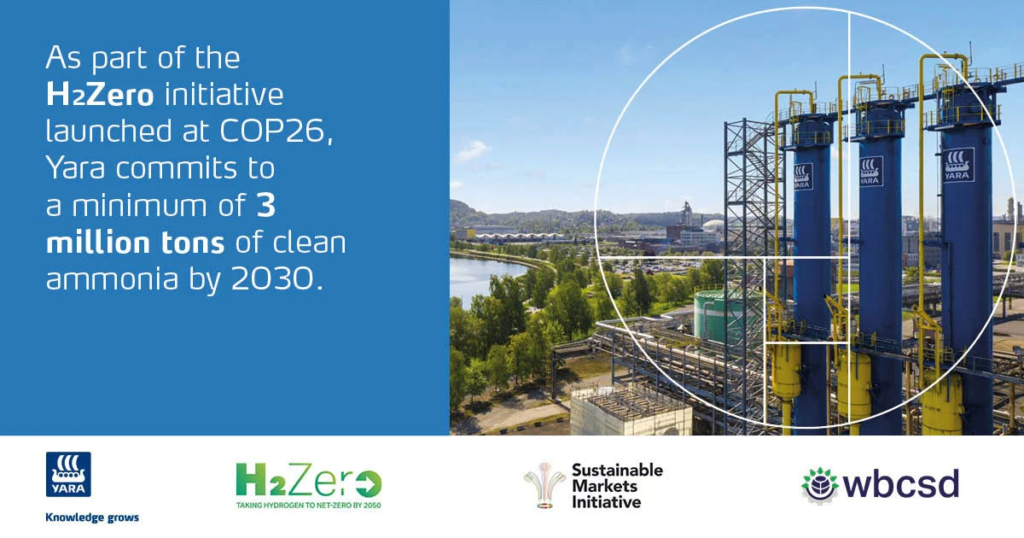H2Zero launches at COP26
By Julian Atchison on November 18, 2021

A group of 28 global organisations (H2Zero) announced significant new pledges to drive the development of the global hydrogen industry at COP26 last week. On the supply side, the pledges add up to 18 million tonnes per year “lower carbon” hydrogen landing in global markets, displacing fossil hydrogen, conventional transport fuel and natural gas for industrial heating applications. On the demand side (including the use of lower carbon hydrogen for fertiliser, chemicals and explosives production), the pledges add up to 1.6 million tonnes. Of particular interest is Yara’s pledge to source &/or produce at least 3 million tonnes of reduced carbon ammonia by 2030:
Yara pledges to source and/or produce a minimum of 3 million tonnes of reduced-carbon ammonia (equivalent of 530 kt of reduced-carbon hydrogen) by 2030, of which minimum 50 % will be low-carbon or ultra-low carbon.
Hydrogen Pledges from H2Zero Members (click to download pdf), World Business Council for Sustainable Development, 9 Nov 2021
Other pledges of note for our Ammonia Energy readers include:
bp
Production of at least 500ktpa new gross low and ultra-low carbon hydrogen in core markets, with up to 50% ultra-low carbon hydrogen from renewable sources. Some of this new production will be used in our European refineries as a substitute for the natural-gas based SMR-grey hydrogen currently used.CUMMINS
Cummins pledges to support the growth of clean hydrogen by scaling up our electrolyzer production capacity to 2GW by 2030 to enable green hydrogen production. Additionally, Cummins pledges to ramp up production capacity to produce fuel cell power modules and components to meet market demand and will continue to invest in research and development to develop new hydrogen products.ENGIE
As part of our commitment to Net Zero by 2045 across all scopes, Engie targets to develop 4GW of renewable hydrogen production by 2030, to deliver low or ultra-low carbon hydrogen under the WBCSD framework definition. As of today, and pending customer’s final decision and grants, our committed volumes represent already 6kt of renewable hydrogen per year.IBERDROLA
Iberdrola plans to have 3 gigawatts (GW) of electrolysers capacity to produce renewable hydrogen by 2030.ITM POWER
ITM Power pledges to support the expansion of green hydrogen by investing £0.4billion in order to increase its electrolyser manufacturing capacity to:
•1 GW p.a. by Q4 2022
•2.5 GW p.a. by Q4 2023
•5 GW p.a. by Q4 2024
This will reduce the full system price of electrolysis by 50% by 2030.JOHNSON MATTHEY
By 2030, Johnson Matthey pledges to invest c.£1bn in the research, development, and deployment of clean hydrogen technologies.LINDE
Hydrogen Pledges from H2Zero Members (click to download pdf), World Business Council for Sustainable Development, 9 Nov 2021
Linde has set a sustainable development target of reducing its GHG intensity 35% by 2028 and to achieve a 35% reduction in our Scope 1 and Scope 2 emissions by 2035 – 35 by 35. Linde is also committed to pursuing our goal of becoming climate-neutral by 2050. To support Linde’s climate change commitment, the company plans to triple the amount of clean hydrogen produced.
“Ultra-low carbon” hydrogen?
For the 28 members of H2Zero, the definition of hydrogen carbon intensity is taken from the taxonomy developed by the European Commission, and the policy recommendations of the World Business Council for Sustainable Development:
The pledges make use of different categories of hydrogen, as defined in WBCSD’s Policy Recommendations to accelerate hydrogen deployment for a 1.5 °C scenario. Key differentiation is based on life-cycle carbon emissions per kilogram of hydrogen produced, from reduced to low-carbon (aligned with the taxonomy developed by the European Commission) to ultra-low-carbon and eventually towards net-zero hydrogen. On top of this, this initiative distinguishes renewable production based on solar, wind and hydro power.
Yara’s official press release, 9 Nov 2021